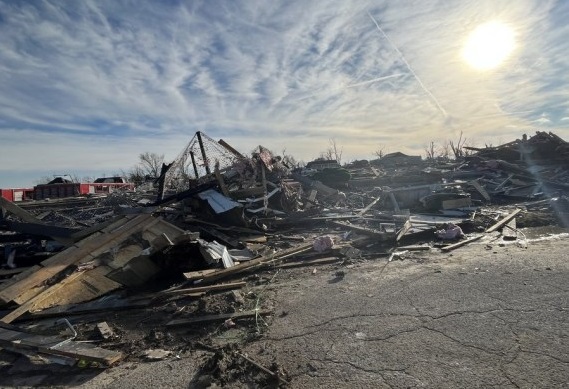Scientists analyze climate change, deadly tornadoes in U.S links
Published : 15 Dec 2021, 01:04
The deadly tornado outbreak that tore through the central United States over the weekend was so unusual in its duration and strength, particularly for December, that many people are asking how climate change might be linked to the event, reported Xinhua.
U.S. President Joe Biden said on Saturday that the intensity of the weather "has some impact as a consequence of the warming of the planet," and called on the Environmental Protection Agency to look at climate change's role in the catastrophe.
According to U.S. meteorologists, the United States averages about 1,500 tornadoes a year, around 25 of which happen in December. But the last tornado "even remotely close" to this weekend's storm was in March 1925, when more than 600 people were killed.
That tornado was on the ground for roughly 219 miles, while the one that just hit the United States was believed to have been on the ground for roughly 250, making it the "most historic tornado event in history," national broadcaster CBS reported on Tuesday.
Experts have termed the weekend disasters as an "unprecedented" weather phenomenon. "The events of Friday are historic, legendary, generational -- pick your favorite adjective," Victor Gensini, an extreme weather and climate researcher at Northern Illinois University, was quoted as saying.
More than 80 people have been killed so far across six states, namely Kentucky, Mississippi, Missouri, Tennessee, Arkansas and Illinois, and these kinds of weather events may only get deadlier as climate change moves coastal populations inland to vulnerable areas, according to the report.
COLD, HEAT
"Many experts have pointed to climate change as part of the reason for the catastrophic events, echoing past warnings that global warming will undoubtedly fuel extreme weather," said the commercial broadcaster upon its extensive interviews with meteorologists and other scientists.
All-news radio station KCBS's meteorologist Evelyn Taft was quoted as saying that the stark contrast in temperatures of the Northeast and Eastern United States created a "perfect setup for such a big storm."
"We had very cold polar air -- 30 (Fahrenheit) degrees in Minneapolis, and then 80-(Fahrenheit)-degree temperatures in Memphis -- record-breaking heat, which could be a part of climate change," said Taft. "Just the difference and the clash in air masses ... It was really just a perfect set up for such a big storm."
However, Gensini insisted that, despite the historic standing of Friday's tornadoes, "we can't tell right now" if it was a direct result of climate change. "We don't have the attribution science to say with some degree of certainty that last Friday evening's tornadoes were a component of climate change," he said.
"But what we can say is when you start to look at the aggregate ... that these tornadoes are sort of changing and not only when they occur -- getting a little bit further eastward -- but changing in their intensity," added the researcher.
TEMPERATURE, MOISTURE
Two key ingredients for severe storms are energy driven by warm, moist air promoting strong updrafts, as well as changing wind speed and direction, known as wind shear, which allows storms to become stronger and longer-lived, reported ScienceAlert on Tuesday, an independently-run online science publication.
A third ingredient, which is harder to identify, is a trigger to get storms to form, such as a really hot day, or perhaps a cold front. Without this ingredient, not every favorable environment leads to severe storms or tornadoes, but the first two conditions still make severe storms more likely, it said.
"By using these ingredients to characterize the likelihood of severe storms and tornadoes forming, climate models can tell us something about the changing risk," said ScienceAlert.
To understand how rising global temperatures will affect the climate in the future, scientists use complex computer models that characterize the whole Earth system, from the Sun's energy streaming in to how the soil responds and everything in between, year to year and season to season.
"Climate model projections for the United States suggest that the overall likelihood of favorable ingredients for severe storms will increase by the end of the 21st century. The main reason is that warming temperatures accompanied by increasing moisture in the atmosphere increases the potential for strong updrafts," added the report.


